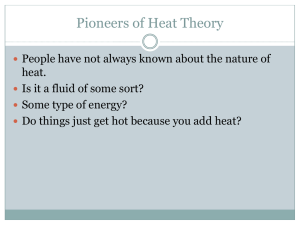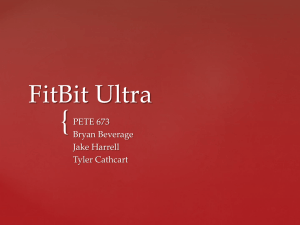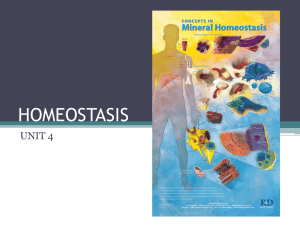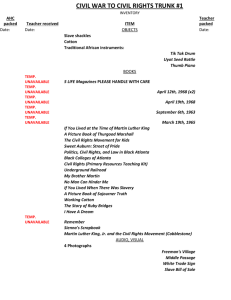Sci Ex Wk 3 Chap 4 – Is Heat a Substance
advertisement
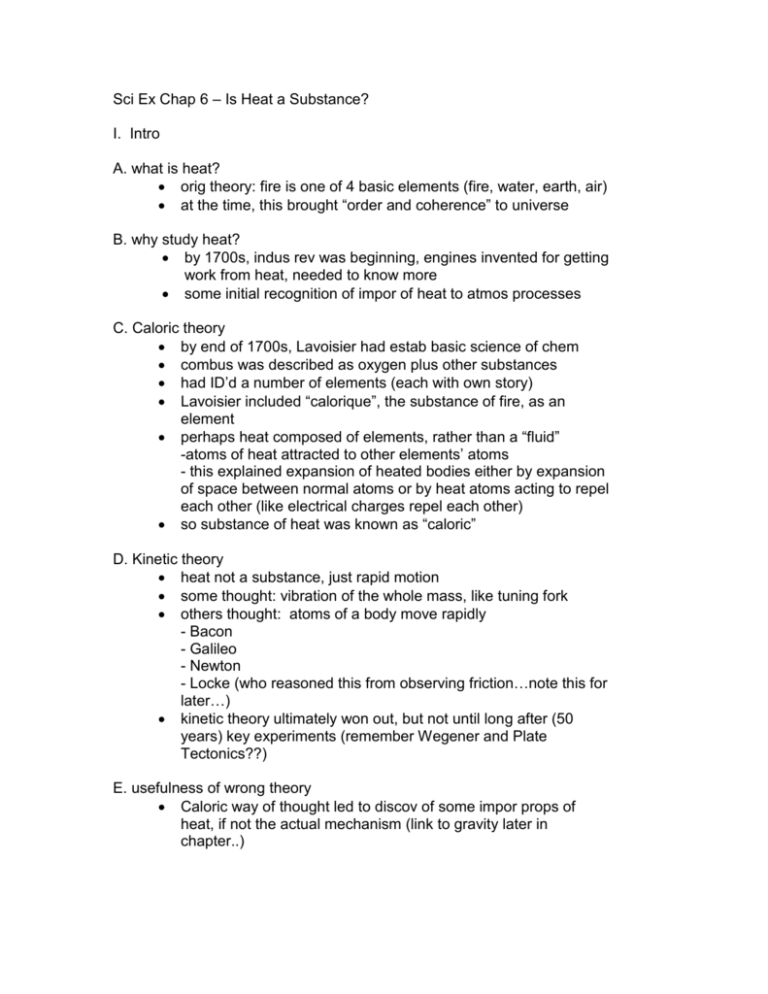
Sci Ex Chap 6 – Is Heat a Substance? I. Intro A. what is heat? orig theory: fire is one of 4 basic elements (fire, water, earth, air) at the time, this brought “order and coherence” to universe B. why study heat? by 1700s, indus rev was beginning, engines invented for getting work from heat, needed to know more some initial recognition of impor of heat to atmos processes C. Caloric theory by end of 1700s, Lavoisier had estab basic science of chem combus was described as oxygen plus other substances had ID’d a number of elements (each with own story) Lavoisier included “calorique”, the substance of fire, as an element perhaps heat composed of elements, rather than a “fluid” -atoms of heat attracted to other elements’ atoms - this explained expansion of heated bodies either by expansion of space between normal atoms or by heat atoms acting to repel each other (like electrical charges repel each other) so substance of heat was known as “caloric” D. Kinetic theory heat not a substance, just rapid motion some thought: vibration of the whole mass, like tuning fork others thought: atoms of a body move rapidly - Bacon - Galileo - Newton - Locke (who reasoned this from observing friction…note this for later…) kinetic theory ultimately won out, but not until long after (50 years) key experiments (remember Wegener and Plate Tectonics??) E. usefulness of wrong theory Caloric way of thought led to discov of some impor props of heat, if not the actual mechanism (link to gravity later in chapter..) like effluvia theory, where some good public health measures resulted from thinking about disease as communicable why caloric theory prevalent? - explained the then known props of heat, while kinetic didn’t seem to... Sci Ex Wk 3 p.2 F. Important points in this story quantitative msrmt very important diff betw temp and heat heat capacity a crucial concept latent heat impor too Rumford shows heat has no weight (so how can it be a substance?) disproof of conservation of heat, central to the caloric theory Rumford still unable to convince contemporaries in two big ways: 1. no convincing quantitative relation between friction and heat 2. how transmit molecular motion across a vacuum?? couldn’t show it II. measuring “hotness” A. inventing means of msrmt impor in science - quantification improves precision B. prior to thermometer, heat judged qualitatively - eg, Francis Bacon made list of things with heat (p.69) C. so a standard was needed for msrmt already done for distance and for weight Galileo made first thermometer in __?___ ones now very similar to original thermom better at sensing small diffs in T than our senses so how standardize? - use 2 reference pts 1. “ice point” of water 2. boiling point of water - then arbitrarily select 100o between the 2 or 180o “ so what does the thermom actually measure? - doesn’t always agree with our impressions (bare floor vs slippers) - but scientists trust the device anyway, because it made measurements that made sense (eg, mixing boiling and freezing water yielded 50o C) Sci Ex Wk 3 p.3 D. concept of equilibrium of heat all objects come to same temp in same environment this temp known as equil temp some things feel hotter or colder, even if temp same (cold floor , warm slippers) E. Science and Quantification try to make things quantitative, not just qualitative exact vs inexact science…nothing exact III. Heat and heat capacity A. heat “transfer” iron bars next to each other…hot and cold thermometers in the bars show heat is “transferred” (like a substance?) backdrop here: in 1700s, light, heat, elec all thought to be “substances” - believed to be “subtle fluids” composed of “light atoms” B. matter “neither created nor destroyed” in vogue at the time example- burn wood, look at products: C, H, O in CO2 and water. they weigh the same as the orig wood and air. this implies conservation. heat appeared to be conserved too, so they linked it to matter C. Joseph Black and heat vs temp discussed both caloric and kinetic theories, leaned toward which?? he distinguished between heat and temp - temp is the intensity of the heat, but not the AMOUNT of heat - example of iron nail and iron block in furnace.. both measure same temp, but if quenched give off much diff amts of heat to the water bath D. Heat Capacity equal amts of “quicksilver” (which is WHAT?) and water don’t hold equal amts of heat he stumbled onto the “heat capacity” of diff substances as different he saw no general principle in effect at the time to explain or predict what would happen when two things were brought together the conservation concept was important here; it allowed him to develop an equation that worked - take mercury at 100o C, put it in 0 o C water - water temp rises from 0 to 3 o C Sci Ex Wk 3 p.4 - quantify this relationship, define the “amt of heat” by using the rise in temp produced in a substance: Q = C amt heat released or absorbed= heat capac x x (t2-t1) change in temp “Calorie” arbitrarily determined as the unit of heat measurement (for Q) 1 cal = amt of heat req to raise the temp of 1 kg of water 1 degree C assume conservancy in heat transfer, look at mercury / water example Qm = Qw (heat lost = heat gained) Cm x (100o – 3o) = Cw x (3o-0o) Cm x 97 = Cw x 3 Cm = 3/97 x Cw = .03 x Cw; Cw defined as 1 this suggests that water’s “capacity for heat” is 30 times that of mercury experimental test – make a prediction as to what equil temp should be: 1 kg mercury at 100o C Cm = .03 o 1 kg copper at 0 C Cc = .09 Qm Cm x (100-t) = Qc = Cc x (t-0), solve for t .03 x (100-t) 3 -.03t 3 3/.12 25 = .09 x t = .09 t = .12 t = t = t perform the test……it works….equil temp is 25oC this lended support to the caloric theory E. heat capac and the two theories HC didn’t fit too well with kinetic theory heavy substances have a low capac for heat, but black felt this should be the opposite…he felt that it should require MORE heat to get heavy molecules moving rapidly than light molecules…. Sci Ex wk3 p.5 F. practical consequences of heat capacity measures how well a substance resists a change int temp turns out that water has one of the highest heat capacities known - many consequences for Earth, in terms of large bodies of water like large lakes or ocean….much influence on climate because water can absorb and release so much heat energy IV. Latent Heat A. Melting ice Black found two statements not equivalent: 1. To raise temp, heat must be added 2. If heat is added, temp must rise (#2 not always true…) to melt, then temp stays at 0o C until all ice melted, then temp starts to rise again… (Fig 9, p.87) so ice has a great “capacity” for taking in heat while resisting a change in temp.. B. Latent heat and caloric how reconcile? 1. definite amt of heat required to melt an amt of ice (144 BTU per lb) 2. found that heat was conserved when process reversed (water gives up that heat when it reverts to ice) 3. model was developed of a chem rxn between caloric and other molcules…caloric made other molecules “slippery” and more “fluid” C. flow of heat and caloric 1820-30, Fourier developed quantitative approach to heat transfer using an analogy to water (a substance) Carnot worked on steam engines, water analogies worked there as well V. Count Rumford & kinetic theory 1753-1814, born in Mass, sided with British in Rev War “unsavory person….but good moral character not a prerequisite for scientists” lots of rsch on heat by analyzing clothing, field stoves, ballistics, cannon manufacture he first read about heat from Boerhaave…”heat is a vibration too high to be heard as a sound but is sensed by the skin” Sci Ex wk3 p.6 A. Rumford vs Caloric 3 key experiments: 1. test if caloric has weight…which it should have if it’s a substance 2. friction (noted by Bacon and Locke) can produce an unlimited amt of heat (upsets the theory of heat conservation important to caloric as matter) 3. showed atoms of matter do move without artifically exciting them (suggested that molecules could be a viable mech for heat transfer) 1. Weight of Heat experiment if heat has weight , it almost certainly is a substance if no weight, it may be something else Rumford compared wt of water at 32oF to wt of ice at 32oF (after losing 144 BTU) - first results were that ice gained weight when heat was lost, so heat had negative weight….he had trouble with this…checked his equip, didn’t find anything wrong at first Rumford tried a diff experiment, -msr wt of mercury vs water as they cooled…water loses 30 times more heat than mercury, but their weights remained the same during cooling…so this suggested that heat had no weight (which he suspected) Rumford revisited his first experiment to look for errors. Found he might not have acct’d for glass containers changing wt and becoming more dense with cold temp, so he redid experiment. -this time, he put thermometers in air, in ice, in antifreeze sol’n….pre-cooled everything….found no change in weight between water and ice….heat once again determined to be weightless… 2. Heat from Friction experiment it had been known that friction generates heat, and caloric believers were able to discount Rumford’s finding… Rumford looked at the cannon-boring process, looked at the metal shavings produced If heat capac of metal shavings was less than that of the bulk metal from which they came, then it followed that heat would’ve been released from the bulk metal during the boring process…(I don’t get this…) Rumford found no diff in heat capacity to test for possible chem rxns occuring in air, he immersed apparatus in water, with dramatic results…..water became so hot it boiled Sci Ex wk 3 p. 7 His conclusion was that supply of heat was “inexhaustible”, in direct contradiction to caloric theory Caloric theory said heat was neither created nor destroyed, merely transported from object to object…….Rumford pointed out that: “anything….(that a body)… can continue to furnish without limitation cannot be a material substance” he cited motion as the communicator of heat, but also acknowledged he didn’t know how it worked he cited Newton in his defense…just because we don’t understand the mechanism of how gravity works doesn’t mean we can’t recognize it’s effects or “laws of its actions” B. Why Rumford “didn’t win” possibilities other than motion were still there to explain his cannon experiment results, like the surfaces were altered, and the alteration caused the heat caloric theory could still explain a lot of things… an aside…Joule was later able to relate “work done” to “heat produced” 3. Molecular Motion Experiment A. Salt sol’n experiment, with a drop of oil floating at salt-fresh water interface - results indicate that molecules move and mix on their own, without stirring or agitation - oil droplet rose on its own as the salt sol’n diffused through the fresh water B. Heat as molecular motion Fig 13 travel paths between collisions decrease from gas > liq > solid temp of substance related to speed of molecules; higher the T, the faster they move easier to excite light molecules than heavier (remember Black’s problem), so heavy ones move slower at a given temp than do light ones Sci Ex wk 3 p.8 VII. why caloric survived A. Heat and vacuum -opposing theories have diff strengths , wknesses - so what facts are most important to explain? - how can atoms exist in a vacuum? they can’t - so how can heat be transmitted in a vacuum? ……in theory, Rumford had to call upon “undulations in the ether”, a wave motion, but this required heat to be both radiant and atomic… - this was more of a stretch at this time than just thinking about caloric “jumping” from hot to cold bodies in a vacuum…easier to grasp than wave motion… B. Light and Heat by early 1800s, light was found to be well-described by wave motion heat was found to be an invisible form of light energy (the infrared portion of the radiant energy spectrum) this paved the way for the kinetic theory of heat, 50 yrs after Rumford… Wegener, are you listening?
